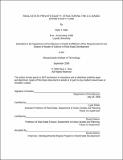Real estate private equity : structuring the U.S.-based opportunity fund
Author(s)
Haas, Ryan J. (Ryan Joseph)
DownloadFull printable version (173.0Kb)
Other Contributors
Massachusetts Institute of Technology. Dept. of Architecture.
Advisor
Lynn Fisher and David Geltner.
Terms of use
Metadata
Show full item recordAbstract
It has been estimated that over 150 real estate opportunity fund sponsors have emerged since the advent of the so called "Real Estate Opportunity Fund" industry. The industry, now more than 15 years old, has experienced significant growth since its inception. As the real estate private equity industry continues to mature and becomes more competitive, fund sponsors must ensure that they are best in class in all facets of their business, and the structuring of their investment vehicle is a perfect place to start. The purpose of this paper is to identify the most important fund level structuring issues facing real estate opportunity fund sponsors when raising a new fund. It begins by reviewing the history of the real estate private equity industry, specifically real estate opportunity funds. The study follows with a recounting of the industry's standard legal, financial, and tax structures for these funds. Finally, utilizing the results of a comprehensive industry survey and interview process, the paper gives an update of the current industry practices. After a thorough study, it is clear that a fund's structure will largely be determined by the investor makeup and the respective fund strategy. (cont.) This fact implies that there can truly be no "one-size-fits-all" best practice. While no particular new best practices were uncovered, the results were very interesting, and they provide general guidelines for fund sponsors to follow given a variety of different circumstances.
Description
Thesis (S.M.)--Massachusetts Institute of Technology, Dept. of Architecture, 2006. This electronic version was submitted by the student author. The certified thesis is available in the Institute Archives and Special Collections. Includes bibliographical references (leaf 43).
Date issued
2006Department
Massachusetts Institute of Technology. Department of ArchitecturePublisher
Massachusetts Institute of Technology
Keywords
Architecture.